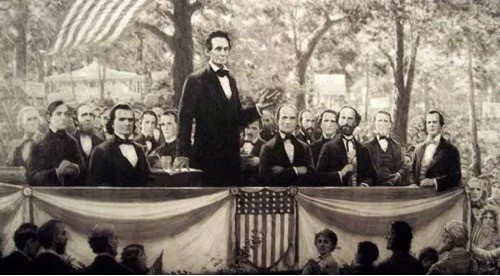Lincoln Douglas Debate Monument, Alton Illinois
Introduction
Text-to-speech Audio
Dedicated in 1995, these life-sized statues commemorate the last of the seven-debate tour between Abraham Lincoln and Stephen Douglas, which concluded at Alton, Illinois, on October 15, 1858. These debates represent a pivotal moment in history and one that became the turning point in Lincoln's political career, even if he did not prevail in that local election. The debates pushed Lincoln and other members of the more liberal wing of the Republican Party that there was no middle ground on the issue of slavery.
Images


Backstory and Context
Text-to-speech Audio
Even stripped of all the lore and legend, the Lincoln-Douglas Debates were momentous occasions. While debates and stump speaking by political candidates were common in Illinois, this campaign was unprecedented. It was exceptional because, at the time, politicians did not campaign directly for the U.S. Senate as the State Legislature chose the senators, not the voters. The fact that Lincoln and Douglas were campaigning and appealing directly to the voters was highly irregular. Second, the campaign was significant because of the importance of the slave issue to national politics.
On October 14th, 1858, Lincoln left Quincy, Illinois, the site of the sixth debate, and traveled with Stephen Douglas down the Mississippi River on the steamer, the City of Louisiana. They reached Alton by 5 a.m. on Friday morning, October 15th. Both men were hoarse and near exhaustion from the strain of campaigning. Lincoln made his way to the Franklin House to rest where he met Mary Todd and their eldest son, Robert. They had arrived by train that same morning from Springfield.
The day was dreary, blustery, and rainy. Nevertheless, people began arriving early in the morning. They came by horseback, carriage, and every other imaginable kind of wagon. The steamer Baltimore from St. Louis brought a load of passengers. By about 10:30 in the morning, the train on the Chicago, Alton & St. Louis railroad brought people from Springfield, Auburn, Girard, Carlinville, Brighton, and Monticello. The Alton Weekly Courier reported that other trains, one with eight full cars, also unloaded passengers from an unknown number of towns. About noon, an extra steamer from St. Louis, the White Cloud, landed at the levee.
Into this hubbub of about 6000 spectators marched the Springfield Cadets, a military company that paraded through the streets. The company camped by Merritt’s Coronet Band which played music for the milling crowd. Early in the afternoon, a band from Edwardsville arrived to charm the senses and soothe dull care away.
According to the Weekly Courier, the people went up and down the streets, some “hurrahed for Lincoln” and others shouted “huzzahs for Douglas.” People thronged the stores, choked the street corners, and jostled through the streets. Arguments broke out among passionate supporters. Fists shook, but few punches flew through the air. All the while, vendors sold their wares. Saloons filled up with people looking for food and drink. With flags flapping and signs waving, the Weekly Courier pronounced the entire affair a glorious display of democracy.
By agreement, neither Lincoln nor Douglas organized a parade or demonstration as they made their way to the platform. At 2 o’clock in the afternoon, in front of the new city hall, Lincoln and Douglas began their three-hour debate. The people crowded close to the platform to hear as best they could. Douglas opened the debate, speaking for an hour. Lincoln followed with a 90-minute rejoinder and Douglas closed the debate with a 30-minute conclusion.
In his opening, Douglas used many of the same arguments that he employed throughout the campaign. Specifically, Douglas said that Lincoln’s “House Divided” speech showed that the Republicans were an extreme party of radicals that opposed the legitimate ruling of the Supreme Court in the Dred Scott Case. The “Little Giant” also attacked Lincoln for supporting the equality of the races. He then turned to his own defense. Douglas declared that he was the true moderate between two extremes: the abolitionist Republicans in the North and the fire-eating slaver-owners in the South. Douglas said that he was trying to preserve the nation as our Founding Fathers had created it and that he was defending our freedoms against radicals and extremists.
Lincoln’s response had a calculated response to show that he and the Republicans, not Douglas, were the conservatives and defenders of the Founding Fathers’ original intentions. Lincoln argued that it was slavery that threatened freedom and democracy and that its advocates had perverted the Constitution and the founding principles of the nation. If left unchecked, he declared, the power of slavery would eventually take away our freedom, first by making the territories open for slavery and then by making it illegal for any state to prohibit slavery. Lincoln shrugged off the charge of being in favor of racial equality by saying that he had “no purpose…to introduce political and social equality between the white and Black races.”
The pro-Republican Chicago Tribune reported that the speakers did not generate more than ordinary applause. Perhaps the lack of enthusiastic cheering reflected the drab weather, or perhaps the crowd was merely responding to Lincoln’s and Douglas’ physical exhaustion. Both men looked to the end of the campaign. Lincoln left Alton the next day by train, heading to Lincoln, Illinois, while Douglas took a train to Decatur. In a few short weeks, Lincoln learned that he had not been successful in persuading voters to support Republican candidates in his bid to win the Senate seat occupied by Stephen A. Douglas. Nevertheless, the Alton Debate was part of a turning point that eventually led to the election of Lincoln as President of the United States and the end of slavery.
Sources
Augustyn, Adam. Lincoln-Douglas Debates, Britannica. Accessed November 26th, 2022. https://www.britannica.com/event/Lincoln-Douglas-debates.
Eller, Daniel. The Lincoln-Douglas Debate in Alton, State of Illinois. Accessed November 26th, 2022. https://www2.illinois.gov/dnrhistoric/Research/IllinoisHistory/Documents/208Eller.pdf.
Original entry written by Dr. Stephen Hansen and edited by Jessica Guldner
